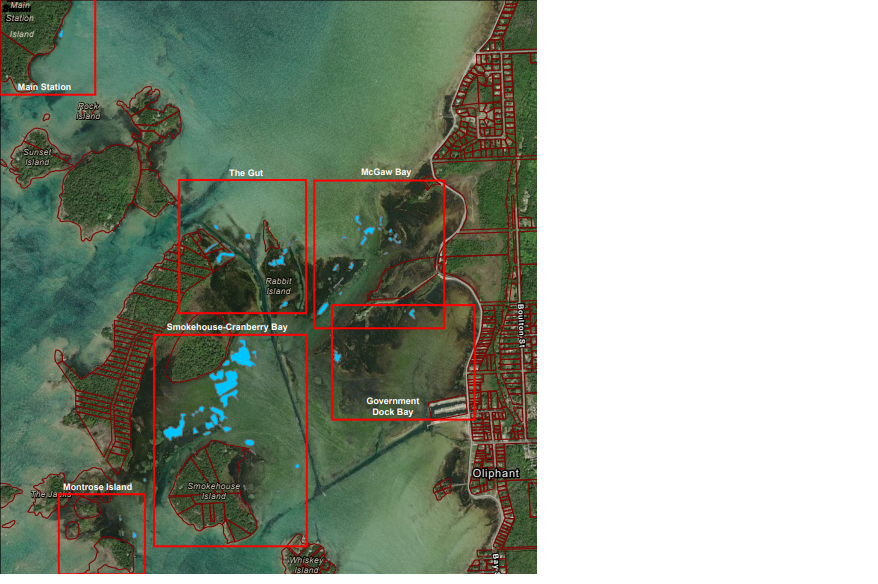Current Phragmites Control
Invasive Phragmites Control Locations
Chiefs Point and Sauble River – Habitat Aqua
Phragmites Control Notification
Chiefs Point and Sauble River
Control Dates: September 8-10, 2025
Control using Habitat Aqua is scheduled for September 8-10, 2025 (weather permitting).
Specific control locations for each day will be posted a minimum of 24 hours prior to control commencing. Phragmites control locations are indicated by the blue polygons on the map(s) below.
Please note there are water use restrictions associated with the use of Habitat Aqua. For more information on water use restrictions associated with Habitat Aqua, please visit the Habitat Aqua FAQ page.
Oliphant (offshore) and Fishing Islands - Habitat Aqua
Phragmites Control Notification
Oliphant (offshore) & The Fishing Islands
Control Dates: September 2 - 5, 2025
Phragmites control using Habitat Aqua is scheduled for the dates of September 2nd to September 5th, 2025 (weather permitting).
Specific control locations for each day will be posted a minimum of 24 hours prior to control commencing. Phragmites control locations are indicated by the blue polygons on the map(s) below.
Please note there are water use restrictions associated with the use of Habitat Aqua. For more information on water use restrictions associated with Habitat Aqua, please visit the Habitat Aqua FAQ page.
Habitat Aqua FAQ
-
Habitat Aqua is a low-volume, aquatic herbicide developed for the control of invasive or undesirable emergent aquatic vegetation (vegetation growing above the water) and does not impact submergent (underwater) vegetation. It is specifically formulated for use in and around aquatic sites.
-
Habitat Aqua is applied directly to the foliage of the target plant, where it is readily absorbed and translocated (moved) throughout the plant. In perennial plants, such as invasive Phragmites, the herbicide is translocated into underground or submerged storage organs (e.g. root systems), which not only kills the plant, but also prevents re-growth. This type of herbicide is considered a systemic herbicide.
-
Habitat Aqua is designed for use in and around standing and flowing water – including lakes, slow moving rivers, streams, ponds, drainage ditches, reservoirs, terrestrial and aquatic sites, seasonal wet areas, and more.
When Habitat Aqua is proposed for use in a wet site, permits must be secured before use.
-
Herbicides provide the most efficient and effective way to control large stands of Phragmites. If left uncontrolled, Phragmites can have negative environmental, social, and economic impacts. These negative impacts include loss of habitat, biodiversity and species richness, human safety hazards such as fire and sightline hazards, and obstruction of drainage ditches.
The negative impacts posed by uncontrolled Phragmites far outweigh any unintended impacts resulting from control efforts. Care is taken to minimize potential impacts associated with herbicide use. Application is completed as per label directions, at a time of year when impacts to non-target species are minimized, and by fully licensed, trained, and experienced applicators.
-
Only individuals who are licensed in accordance with Provincial law can apply Habitat Aqua. Use of this product in or immediately adjacent to water bodies must be appropriately authorized and applied in accordance with Provincial Regulations. Approval is required from the Ministry of Environment, Conservation and Parks (MECP) for aquatic herbicide application.
-
Herbicide application occurs between August 15 and October 15. This timing window allows for optimum control results, while minimizing potential impacts to non-target plants and animals.
For optimum results when using herbicide to control Phragmites, application should occur in the late summer or early fall. During this time, Phragmites plants are actively transferring nutrients to their root systems (rhizomes). This allows systemic herbicides (such as Habitat Aqua) to be translocated as well, directly impacting the root system.
This timing also coincides with reduced activity of native wildlife and dormancy in native vegetation. The breeding and spawning windows for birds, reptiles, amphibians and fish are avoided, and most plants have senesced (i.e. gone to sleep), therefore limiting potential impacts to non-target species.
-
As a precautionary measure, all surface water systems (i.e. intakes from a lake) for potable uses (i.e. for drinking, cooking, or food preparation) within 1km of an application area must be turned off during application and for a minimum of 48 hours after application. Systems should be flushed for at least 20 minutes before consuming again. Please note: these precautionary measures are only for private water systems drawing directly from the water body to be treated. This does not apply to groundwater wells or other water systems.
Access by people through an application area is restricted until the herbicide has dried on the plant leaves (access restricted for a minimum of 1 hour).
Please note that there is no restriction on the use of water for recreation or domestic purposes (toilets, showers, etc.).
-
All herbicides available for use in Canada are registered by Health Canada’s Pest Management Regulatory Agency (PMRA). The registration decision can be viewed at the following link: Registration Decision RD2021-03, Imazapyr, Habitat Aqua - Canada.ca
Each pesticide registered for use requires a label. The pesticide label is the primary information source for the safe and effective use of the pesticide. Habitat Aqua’s label is available at the following link: view_label (hc-sc.gc.ca)
Approval is required from the Ministry of Environment, Conservation, and Parks (MECP) for aquatic herbicide application. Questions regarding the review and approval process for Habitat Aqua use can be directed to your Regional MECP Office: https://www.infogo.gov.on.ca//infogo/home.html#orgProfile/-270/en
Additional information about the product is available on the manufacturers website: https://www.better-vegetation-management.basf.ca/en/products/habitat-aqua.html

